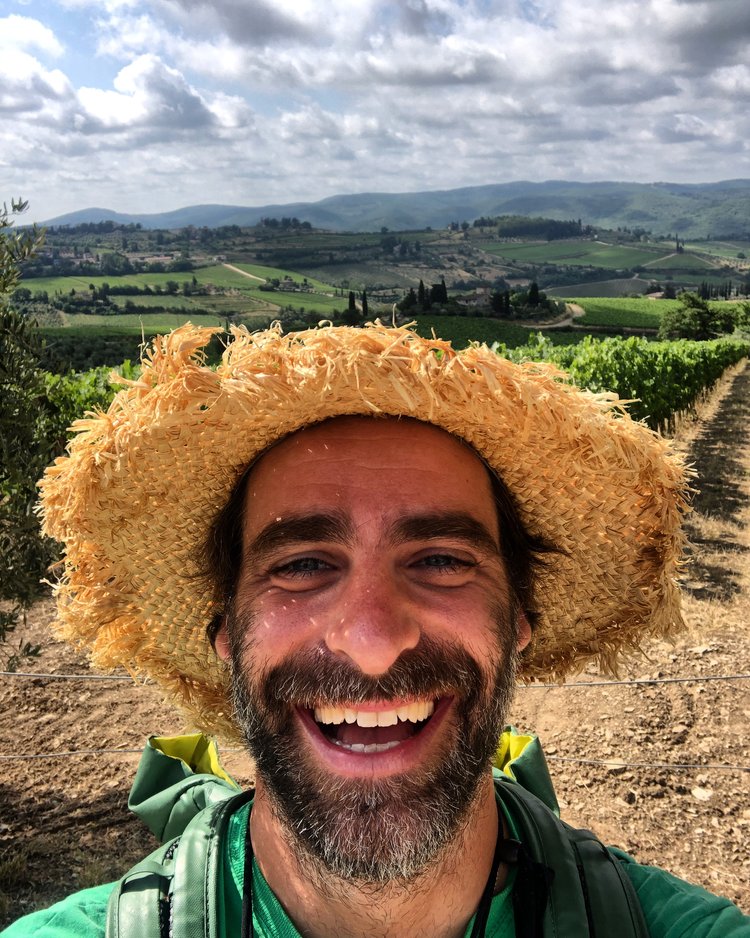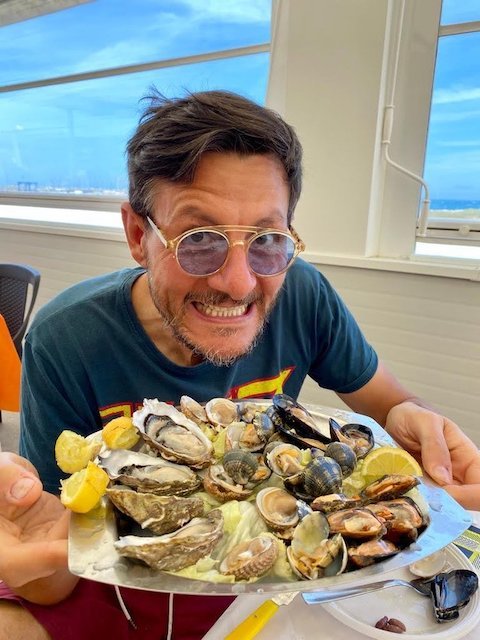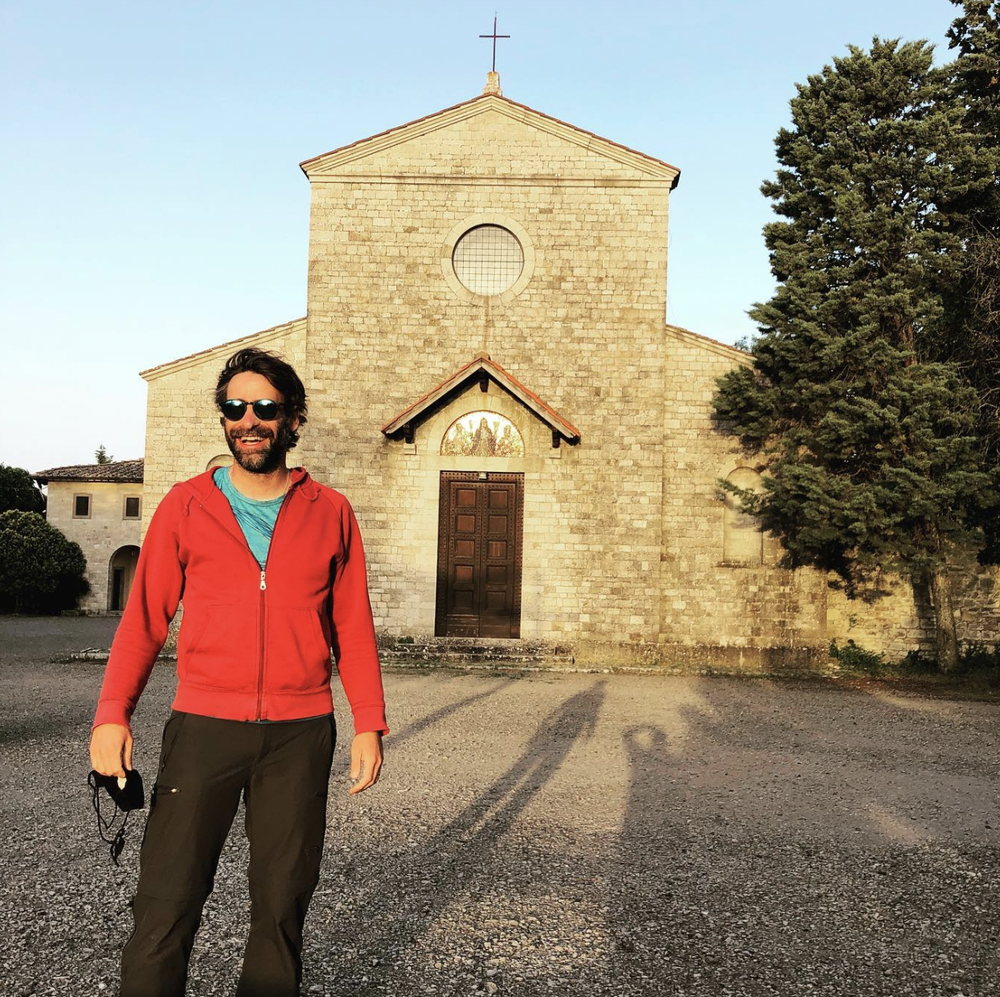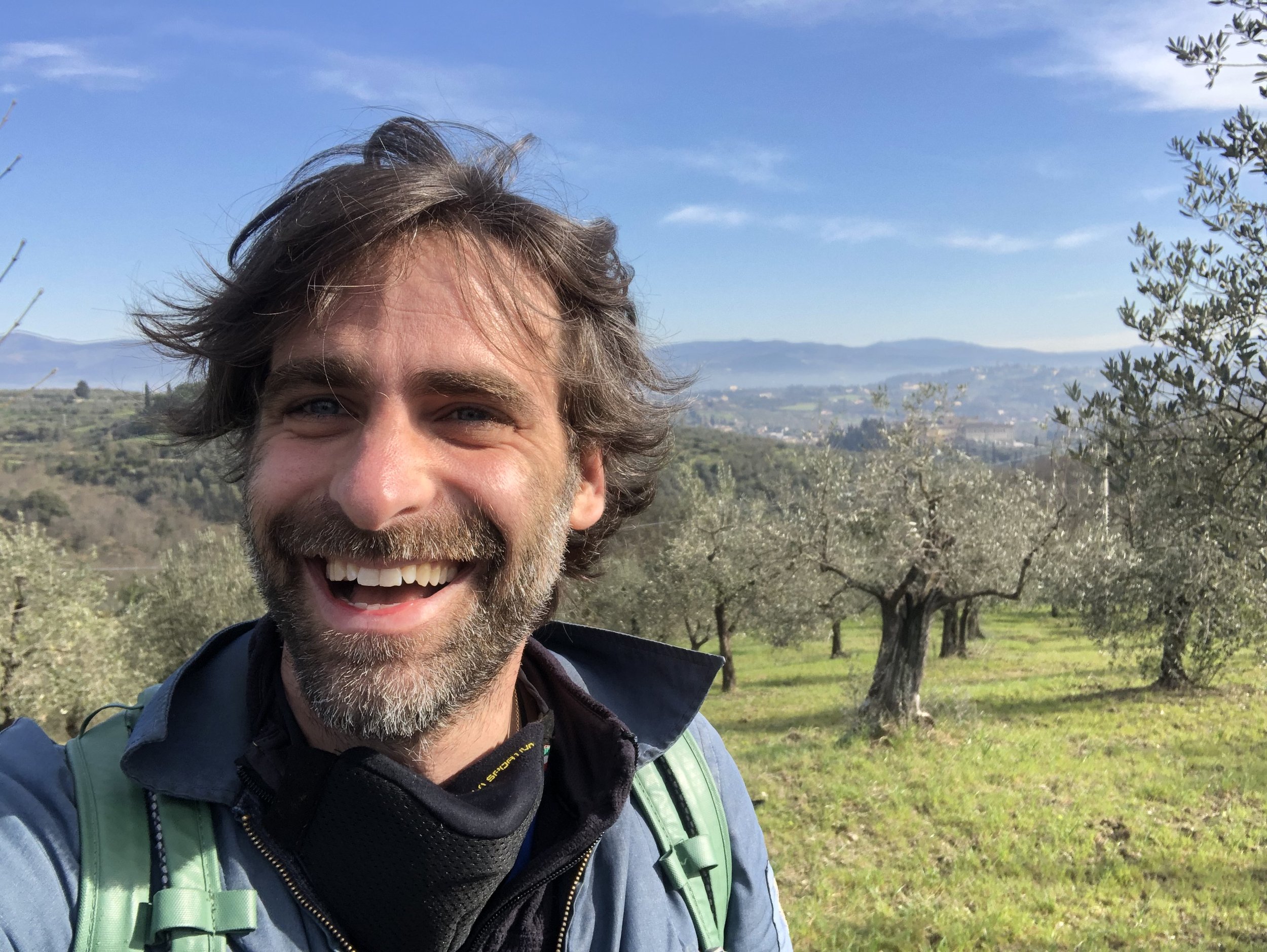Travel Guide to Bologna - the Food Capital of Italy
Affiliate disclosure: some of the links in this article are affiliate links. If you book using one of them, we’ll earn a small commission. All of our info is free to read and free of ads, so we appreciate it!
What is there not to like about this beautiful and prosperous city on the plains of the Po River? As the poet Goethe once said of Sicily, “The key to it all is here”, and I think that same phrase applies equally to Bologna.
The capital of the Emilia Romagna region, Bologna serves up some of Italy’s best food, and the city’s culinary efforts have earned it the nickname “La Grassa,” the well-fed. Home to Europe’s oldest university, hence Bologna is also known as “La Dotta,” the learned, this is an edgy, youthful, and left leaning place.
The population’s political affiliation has also led to it being called “La Rossa,” or the red (for communism), though the sea of red roof tiles seen from any height may have inspired this nickname as well.
Regardless, as you can tell, the city has a lot of nicknames!
Plus, in Bologna the bella vita transpires in one of Italy’s most attractive, and second only to Venice, best preserved cities, the largest remaining medieval enclave in all of Europe.
On even a short visit you’ll eat well, see a lot, and as you walk down lanes right out of the Middle Ages and emerge into eye-popping squares, you might not even notice the elements, since the city’s sidewalks are covered by 25 miles of graceful porticos that protect you from the sun, rain, or any other weather that may come your way.
Table of Contents
Bologna planning cheatsheet
 Plan your itinerary with expert advice
Plan your itinerary with expert advice
- Book an Italy travel consultation with a local expert
 My favorite hotels in Bologna
My favorite hotels in Bologna
- Grand Hotel Majestic - For when money is no issue, by far the city's best hotel. $700+/night
- Art Hotel Orologio - Historic property in the heart of the city center. $250-350/night
- Hotel Brun - Beautiful and recently renovated boutique hotel. $200-300/night
- Hotel Accademia - Cute little modern hotel near the University District. $150-200/night
- Almarossa - Cheerful rooms and serviced apartments at a great price. $120-200/night
- Il Guercino - Eclectic and colorful with fun vibes in Bolognina. $100-150/night
 Guided tours and activities
Guided tours and activities
 How to get around
How to get around
- Car rentals with DiscoverCars
- Train tickets via Trenitalia and Italo
Why visit?
The most compelling reason to visit Bologna is a tempting one: simply to enjoy many of the good things in life. Visually, the city is a feast, a large-scale time capsule of the Middle Ages. Bologna is said to preserve the largest concentration of medieval architecture in Europe, and of Italian cities, only Venice tops Bologna when it comes to historic conservation.
Fortunately, you can enjoy the wonderfully intact city center with very little effort. Many streets and squares are closed to traffic, and a stroll just about anywhere along portico-covered sidewalks leads past medieval houses and brick palaces.
A well-worn route leads from Piazza Maggiore, the city center, through the Quadrilatero, the centuries-old market district, into Piazza Porta Ravegnana, in the shadow of the city’s two signature medieval towers, and from there up Via Zamboni into the university district. The presence of this university, the oldest in Europe, brings a lot of youthful energy to the old streets (along with inexpensive food, bars, and music).
And then there’s the food: even Italians from other regions agree that the food in Bologna is some of the best in the country, and that’s saying a lot. Dining, whether simply or extravagantly in the many ristorante and trattorias, is one of Bologna’s great pleasures.
Even when you’re not tasting the city’s signature pastas and sauces you’ll find yourself admiring huge wheels of Parmigiana cheese and aged hams in shop windows.
Where is Bologna?
Bologna, the capital and largest city of Emilia-Romagna, is in north central Italy, 104km (65 miles) north of Florence and 215km (134 miles) south of Milan.
The fertile agricultural plains of the Po River spread to the north while the forested slopes of the Apennine mountains rise to the south.
Although Bologna is firmly landlocked, it’s still within easy reach of the sea - Rimini, a favorite Italian seaside getaway on the Adriatic, is about 120km (75 miles) east and La Spezia, the southern gateway to the popular Cinque Terre on the Ligurian Sea, is about 200km (125 miles) west.
Bologna is close to many other northern cities that are extremely well connected along major highways and rail lines. Modena, Reggio Emilia, and Parma are to the northwest, and Parma, the most distant of these, is only an hour from Bologna.
Ferrara is northeast and Ravenna is southeast, both about an hour away. Venice, meanwhile, is 150km (93 miles) to the northeast.
How to get here
Bologna is on Italy’s major north–south rail lines and sits just off the A1 autostrada that runs between Milan and Naples. So, easily reached by both road and train, Bologna is a breeze to get to from almost anywhere else in Italy.
Arriving by air
Bologna’s Guglielmo Marconi Airport, named for the Bologna native who invented the telegraph and radio, is served by flights to and from many cities in Italy and throughout Europe.
A handy monorail connects the airport with the train station and the trip takes only 7 minutes.
Arriving by train
By high-speed frecciarossa trains, Bologna is just over two hours from Rome, 40 minutes from Florence, a little over an hour from Milan, and an hour and a half from Venice.
Trains run between these cities as often as every 15 minutes throughout the day, starting from early morning and continuing well into the evening.
For nearer destinations, an extensive network of local trains connects Bologna with many cities and towns throughout Emilia-Romagna, again with frequent departures all throughout the day.
The Bologna Centrale train station is at the edge of the historic center, and it’s about a 20-minute walk from there along the city’s famous porticos to Piazza Maggiore, the central square.
You can also catch buses from Piazza Medaglie d’Oro (right in front of the station) to get anywhere and everywhere in the city.
Driving to Bologna
While it’s easy to get to Bologna by car (it’s right off the A1 highway), driving in the city is a challenge, and access to many parts of the historic city center is severely restricted (these are ZTLs - areas where outside traffic is very limited or not allowed).
So, if you’ll be coming here by car, your best bet is to stash the car in one of the many parking lots that ring the city center.

Connect with our Local Experts based throughout Italy for help perfecting your itinerary, answers to all your travel questions, and fabulous local tips for a better visit!
Best time to visit
Bologna’s worst-weather months are July and August, when temperatures climb and the city, nestled in a valley, can become a cauldron. The heavily and atmospherically medieval center, with its narrow lanes and stony squares, has few parks and the only escape from the heat is a trip into the surrounding hills.
So, unless you’re looking to roast while exploring the city, these are the two months that I’d suggest trying to avoid.
Other than that though, Bologna is pleasant to visit at any time of year.
Spring is mild and sunny, with a bit of rain early on (but not too much), and warm temperatures ideal for sitting in outdoor cafes, especially later in the season.
The early fall is lovely, with relatively long days and still pleasantly warm temperatures that make wandering around outside a joy. Evening can get a bit chilly, but in a very nice way, so just be sure to bring a sweater or light jacket with you. It starts to get a bit colder as the season progresses, and a bit more grey and rainy, but not overly so in either case.
Winters, meanwhile, especially December and January, can be pretty cold and snow is not uncommon. Chilly weather shouldn’t be too much of a deterrent though, as a winter trip means that you’ll spend most of your time indoors in churches, museums, and galleries, and enjoying long meals.
Rain falls for at least a few days every month, but you’ll never need an umbrella in Bologna, because most of the sidewalks are covered by porticos.
With a large student population and headquarters for many businesses, Bologna relies less on tourism than Florence, Venice, and Rome do, and unlike other parts of Italy, it doesn’t really have a peak tourist season. Tourism is simply not a major industry here, so the city rarely feels overwhelmed with visitors, and always has a pleasantly local atmosphere.
With its airport and excellent road and rail connections, Bologna is popular throughout the year with other Italians and Europeans for short-break getaways, and it also hosts many trade shows and conventions.
How long to spend
I’d recommend spending at least two full days in Bologna, which should give you a chance to see the major sights, get a sense of the city, and spend some time lingering over cocktails and long meals.
Budget in plenty of time for the latter, because eating and drinking, along with gazing through shop windows at displays of food, are a big part of the Bologna experience.
Three or four days will give you time to explore a little farther afield, and is a nicer amount of time if you’re not in a rush.
Bologna is well connected for day trips to other cities in Emilia-Romagna, and within an hour or so you can find yourself gaping at dazzling Byzantine mosaics in Ravenna, or bicycling along the top of Ferrara’s Renaissance-era walls.
Being just an easy (and inexpensive) train ride away from each of these cities, along with others like Moden and Parma, Bologna is a very convenient base from which to do some day trips throughout Emilia Romagna, especially if you don’t want to rent a car.
See the end of this article for a complete 2-day itinerary.
Where to stay
Neighborhoods/areas to consider
The choicest, most convenient place to stay in Bologna is the historic center, or centro storico. This area is largely medieval and enormous, stretching from the train station all the way to the city gates that open onto the green hills south of Bologna.
Piazza Maggiore, where the cathedral and city hall are located, sits smack dab in the center of the centro storico and just about anywhere you’ll want to go in Bologna is a walk of 20 minutes or less away from this lively square.
Some large, business-oriented hotels are clustered around the train station and along Via Independenza, a shop-lined thoroughfare (largely closed to traffic) that leads from the station to Piazza Maggiore. Other, usually smaller hotels and Air bnbs are on the narrow streets that lead off the Piazza Maggiore.
A stay on or around Via Pratello, to the west, puts you near a string of inexpensive trattorias and bars, while the small Ghetto Ebraico, Jewish Ghetto, to the northeast of the piazza, is quiet and atmospheric.
The University District is on the northwestern edge of the centro storico, with its beautiful palaces and libraries along Via Zamboni and adjacent streets and squares.
The neighborhood might appeal to two diverse types of travelers—handy for those yearning for nightlife and idling away the hours in cafes, as well as for museum goers who want to be near the Pinacoteca, the city’s impressive art gallery, and the university’s various collections devoted to anatomy, geology and other worthy subjects. The only drawback is that anyone past 25 is likely to feel rather old among the tens of thousands of young scholars.
Another central neighborhood, not in the centro storico but just north, is Bolognina. The leafy streets are pleasant and quiet, and Piazza Maggiore and other sights are a walk of about half an hour away. The proximity of the train station makes this neighborhood a good choice if you’re planning on hopping on and off trains to visit nearby cities in Emilia-Romagna.
During times when Bologna is hosting big fairs and conventions, hotels often get booked solid and prices can go up exorbitantly, so plan accordingly.
My recommended hotels
Phi Hotel Bologna - Al Cappello Rosso - Bologna’s oldest inn, just steps off Piazza Maggiore, has been welcoming guests since the 14th century, but the surroundings are chic and upbeat, though accented with old timbers and other reminders of the provenance. From 125 euros.
Hotel Porta San Mamolo - Though the Piazza Maggiore is a short walk away soothing rooms facing a large garden have the atmosphere of a country getaway. From 135 euros.
Albergo delle Drapperie - An atmospheric old inn is set amid the shops of the lively Quadrilatero food district. From 140 euros.
Hotel Metropolitan - Stylish surroundings just off main thoroughfare Via Independenza are a soothing urbane hideout, complimented by a roof terrace. From 185 euros.
Grand Hotel Majestic - The refined surroundings of Bologna’s grandest hotel can make a duke feel like a country bumpkin but the comforts and service are unsurpassed. From 600 euros.
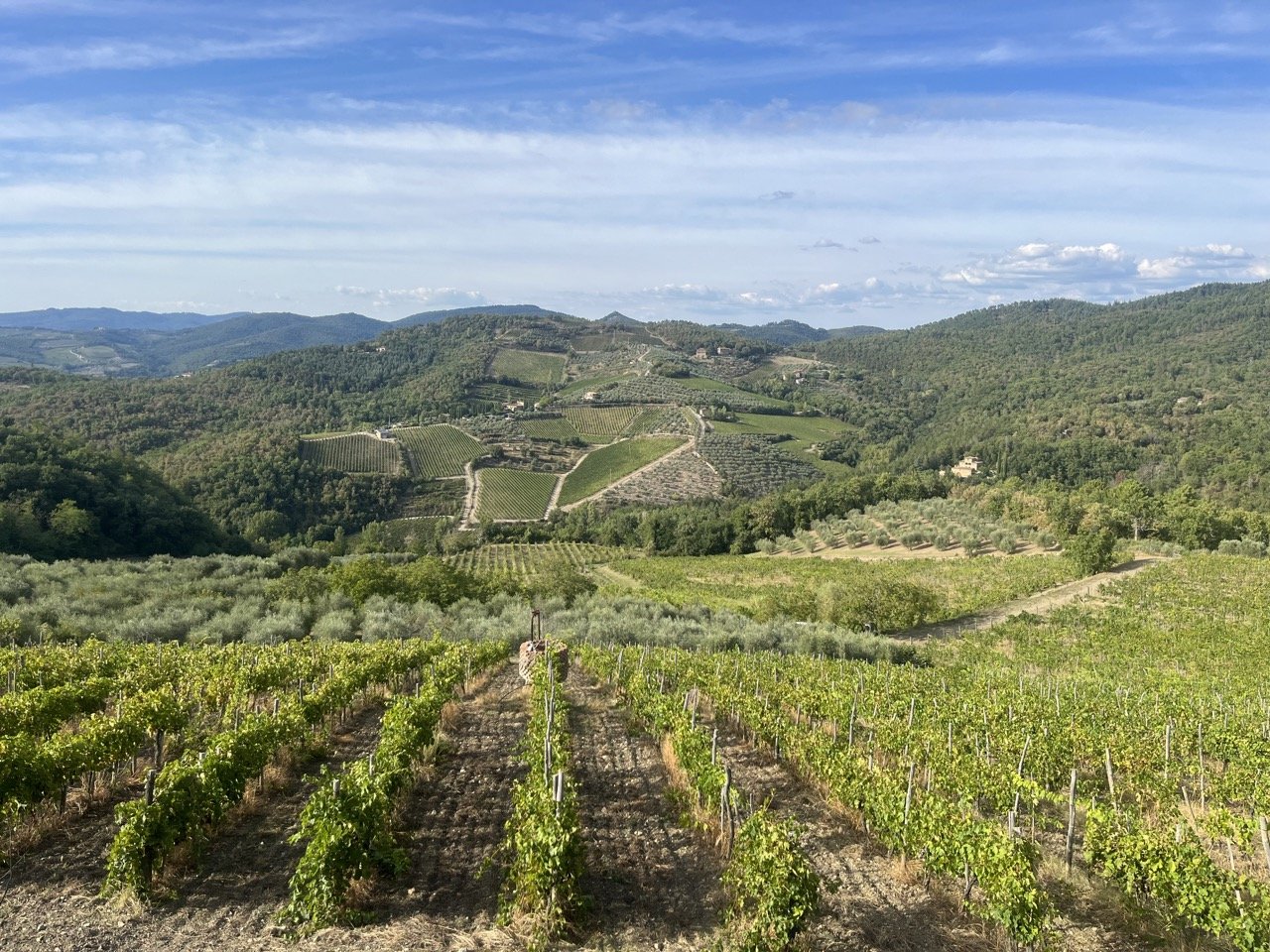
What to see & do
1. Make the rounds of some museums
Bologna has many collections, and one of the most engaging is the Museo Civico Medievale, where statues bring citizens of the past back to life, sporting hair styles and finery of the Middle Ages.
In the city’s Pinacoteca, a painting of “The Ecstasy Santa Cecilia” by Raphael was once infamous for inducing fainting spells among viewers with its depiction of a heavenly choir transporting the saint into a transcendent state. The stars are the Carraccis, a trio of painters who, aside from their paintings here, left frescoes in palaces around the city.
In the Museo d’Arte Moderna (MAMbo) “I Funerali di Togliatti,” depicting the funeral of a leader of the communist party, is awash in a sea of red flags as a tribute to the city’s leftist past.
2. Gaze up at the Due Torri
Bologna must have resembled Manhattan in the 13th century, when more than 100 towers rose high above the rooftops, symbols of wealth and status and also used as watchtowers. About two dozen remain, of varying heights and in various states of repair, but two still rise high, the Torre Garisenda and the Torre Asinelli.
Both lean precipitously and are cordoned off for the time being as surveyors and maintenance crews make sure they remain securely upright.
3. Eat your way through town
Bologna is legendarily famous for food, and an entire district is devoted to gastronomy, the Quadrilatero, filled with market stalls and gourmet shops selling cheese, prosciutto, produce, and the other bounty of the surrounding farmlands.
The narrow lanes have been bustling with commerce since the Middle Ages, and the names of Via delle Pescherie Vecchie (Old Fish Market) and other narrow lanes say it all.
The nearby, iron-and-glass Mercato delle Erbe food hall is another place to stock up on provisions.
4. See the beautiful Teatro Anatomico
The 16th-centuruy Palazzo dell’ Archiginnasio, once the main building of the university, houses one of the city’s most intriguing spaces.
The Teatro Anatomico is a spruce-paneled hall where dissections once took place. A church inquisitor looked on from behind a secret panel to make sure that everything placed out according to Hoyle - dissections had to be completed in one session and organs left in place so the subject could meet his or her maker intact on Judgement Day.
Statues surrounding the room include two flayed men, gli spellati, or skinless ones.
Photo: Palickap, CC BY-SA 4.0, via Wikimedia Commons
5. Learn about Giorgio Morandi
Bologna was home to Italy’s most famous painter of the 20th century, Giorgio Morandi. The bottles and other simple, everyday objects that were the subjects of his still life paintings fill the modest apartment/studio where he lived with his two sisters for much of his life, and his paintings, rendered in muted colors, hang in the Museo Morandi.
6. Catch a glimpse of the hidden canal
By the 12th century a network of canals flowed through Bologna, used to transport materials and goods for the flourishing silk and tobacco trades. Most of these waterways have since been paved over, though a small section remains flowing just off Via Piella.
Even this section isn’t in full view though, so to see the quiet waters slipping beneath the tall houses you need to look through the Finestrella, a shuttered window.
7. Walk along the porticos
Almost 40km (25 miles) of porticos cover the sidewalks of Bologna. While they make it easy to get around the city in rainy weather, they’re much more than a mere convenience. They began appearing in the 13th century, when the city was booming and space was tight.
Porticos allowed landlords to expand their premises over the street and at the same time provided protected outdoor spaces for workshops, reducing the risk of fire.
8. Try to find the three arrows at Casa Isolani
They’re embedded in the timbers of the portico in front of Casa Isolani on Strada Maggiore, and legend has it that they’ve been there since a medieval count hired assassins to kill his beautiful but unfaithful young wife. Seeing the marksman beneath her window, the lady disrobed and so dazzled them with her nude, voluptuous body that they missed their mark entirely.
Casa Isolani
9. Make the climb up to the Santuario della Madonna di San Luca
Bologna’s most monumental portico, the longest in the world, stretches 3.8kms (2 1/2-miles) from the Porta Saragozza up a hillside to the Santuario della Madonna di San Luca.
The graceful but seemingly endless steps are a fitting approach to the city’s most grandiose landmark, a baroque sanctuary that houses an icon of the Virgin Mary that was allegedly painted by Luke the Evangelist.
Pilgrims once prayed their way up the steps, stopping in 15 little chapels along the way and no doubt taking note of the arches that support the roofed arcades - they number 666, the sign of the devil.
Meanwhile, views from the top over green hillsides and the domes and towers of the city below are downright heavenly.
Photo: Sanctuary of the Madonna di San Luca , CC BY-SA 3.0, via Wikimedia Commons
10. Be moved by the Campianto in the Church of Santa Maria della Vita
Some of the most moving religious images you’re likely to encounter in Italy are in the church of Santa Maria della Vita, where seven life-size terracotta figures surround the body of Christ. Their expressions of agony and horror are so realistic that the scene was once kept out of sight of patients in the infirmary adjoining the church, lest they be frightened to death in their weakened states.

Connect with Tuscany travel expert Stefano for help perfecting your itinerary, answers to all your travel questions, and fabulous local tips for a better visit!
11. Discover Bologna’s naughty little secret - the statue of Neptune
At the center of Bologna, a statue of Neptune rises from a fountain fed by sirens who spout water from their breasts. The sea god symbolically presides over the waves, the same way the papal legate who commissioned the work ruled Bologna at the time.
The sculptor, Giambologna soon ran afoul of his patrons, who complained that all the nudity and Neptune’s obvious virility were indecent. He got his revenge by arranging the left hand in such a way that, when the statue is viewed from a certain position, the god’s thumb suggests an obvious state of arousal.
Stand on the black paving stone to the left of the statue to get the full effect.
Photo: Marcok - it.wikipedia.org, CC BY-SA 3.0, via Wikimedia Commons. Cropped from original
12. See the haunting memorials at the Museo per la Memoria di Ustica
Museo per la Memoria di Ustica commemorates 81 passengers and crew who perished when the Italian military mistakenly shot down a plane flying from Bologna to Palermo on June 27, 1980. Wreckage retrieved off the Italian island of Ustica is accompanied by dramatic lighting and sound effects.
A touching display of photos on a wall off one side of Piazza Nettuno commemorates more than 2,000 Bolognese anti-fascist partisans killed during World War II, while the clock outside Bologna’s Stazione Centrale is permanently set to 10:25, the time a bomb exploded on August 2, 1980, killing 85 people and wounding scores more.
13. Get in tune with Bologna’s music scene
Bologna was once a major jazz center, stomping ground for the likes of Chet Baker and Miles Davis. La Strada del Jazz (Jazz Street) commemorates the strip where they played and is also the name of the city’s September jazz festival. Bologna is also a showplace for historic musical instruments.
Harpsichords, pianos, lutes, violins and other instruments are on display in the Museo Internazionale e Biblioteca della Musica in the Palazzo Sanguinetti and the Collezione Tagliavani, in the former church of San Colombo.
14. Learn to make the Bolognese classics
If you’ve been enjoying tagliatelle, tortellini, and the other Bologna classics, Barbara and Valeria will teach you how to make them in their engaging workshops at Salotto di Penelope.
Gelato is another one of Bologna’s culinary specialties, and Carpigiani, a producer of gelato-making machines, houses a gelato museum and offers gelato-making classes and tastings.
15. Tour the museums and factories of Italy’s luxury automakers
Bologna and its surroundings are home to Italy’s top luxury automaker, with Masseratti, Ferarri, and Lamborghini all headquartered near Bologna in the so-called Motor Valley. Because of that, there are various museums throughout the region where these companies showcase their vehicles, and they also sometimes host factory tours.
Motorcycle buffs will be pleased to learn that Ducati is also based in Bologna and also shows off their output with factory tours and in a museum.
16. Take some day trips
Bologna is temptingly close to the many other visit-worthy cities in the Emilia Romagna region, all an easy train ride away. Modena is noted for balsamic vinegar (aceto balsamico), and Parma is famous for ham (prosciutto di Parma) and cheese (Parmigiano Reggiano). Both cities also have remarkable cathedral complexes, along with other art and architectural treasures.
Ferrara is a Renaissance time capsule enclosed within a circuit of walls (these days topped with parks and bicycle and walking paths) and surrounds a massive moated castle.
Ravenna was once capital of the Western Roman Empire and chapels and other monuments are carpeted with magnificent Byzantine mosaics that celebrate the city’s onetime prominence.

Restaurants and dining
Bologna’s big three pastas appear on almost all menus: tortellini, tagliatelle, and lasagna. Long, flat tagliatelli noodles are well suited to heavy sauces, and here that often means salsa Bolognese, a concoction that elevates chopped vegetables, minced beef, and tomato paste to gourmet realms.
Tortellini, stuffed with prosciutto, Parmigiano, and nutmeg, is topped with sauces or served in brodo, broth. It’s said that an innkeeper invented tortellini, with its resemblance to a naval, after spying on a beautiful woman through a peephole.
If you wish to eat like a Bolognese, you’ll approach lunch as a sit-down occasion, with at least a plate of pasta and glass of wine, and not as a quick bite to be wolfed down on the run.
By 6:00 PM or so, the Bolognese set out on a passeggiata (evening stroll), often around Piazza Maggiore and surrounding streets.
The outing usually includes a stop in a bar, where a glass of wine or cocktail is accompanied by cicchetti, small bites, often complimentary, or a platter of local cheeses and prosciutto. Then it’s time for a leisurely dinner.
My recommended restaurants
Below are some of my other favorite restaurants in the city. Note that the prices below are for two, with wine:
Drogheria della Rosa - A former pharmacy now dispenses ever-changing daily choices that often top off pasta with grilled meats. Dinner for two, with wine, about 70 euros.
The Markets - Mercato I Mezzo and Mercato delle Erbe are lined with food stands and bars, and at Mercato delle Erbe you’ll enjoy a meal among the clamor of meat, fish, and produce vendors. Light meal and drink, about 15 euros.
Osteria del Sole - Not a restaurant, in fact the antithesis: at this 500-plus-year-old institution you bring your own food and they supply very affordable wine by the glass, from about 3 euros.
Ristorante da Nello al Montegrappa - Uniformed waiters serve all the Bolognese classics in refined and atmospheric surroundings. Dinner for two, with wine, about 90 euros.
Trattoria dal Biassanot - The pastas served in these homey dining rooms set the standard for local preparations, and you can try a selection on the house’s signature Tris Bologna dish. Dinner for two, with wine, about 80 euros.
Trattoria da Me - A TV chef returned to her native Bologna to take over the trattoria her grandparents opened in the 1930s, adding many tasty new twists. Dinner for two, with wine, about 80 euros.
Via Pratello - Not a restaurant, but an entire street lined with bars and inexpensive trattorias.
Two standout spots (mostly for takeaway) are Capra e Cavoli and Pasta Fresca Naldi, where a selection of daily pastas are served in no-frills surroundings and cost 8 to 10 euros a serving.
How to spend 2 days in Bologna
Day 1: Getting to know Bologna
Begin the day over a coffee in a café on Piazza Maggiore, surrounded by palaces and the basilica di San Petronio. This massive church was intended to be larger than St. Peter’s in Rome, but papal powers took a dim view of these ambitions and the plan was never carried out - hence the plain façade and the transepts that end abruptly in the surrounding streets.
Step inside to see the Cappella dei Magi, with its terrifying depictions of the devil eating doomed souls.
A more playful atmosphere prevails in the adjoining Piazza Nettuno, where the sea god Neptune emerges from a fountain surrounded by sirens and cherubs.
One of the surrounding palaces houses a public library, the Biblioteca Salaborsa, and step inside here, too, to look through the glass floors of the reading rooms to see the remains of Roman Bologna below.
The Palazzo d’Accursio, just around the corner, is Bologna’s city hall. Climb up the grand staircase to heavily frescoed salons filled with paintings then even higher into the clock tower. Two viewing platforms provide views over the piazzas and palaces below and across the domes and tile roofs of the city.
Back on terra firma, the next stop is another extraordinary palace, the Palazzo dell’Archiginnasio. This was once the seat of the university, and among the libraries filled with rare volumes is the stunning Teatro Anatomico, the lecture hall where physicians once learned their craft by dissecting bodies.
The beckoning lanes of the Quadrilatero, the city’s food district, are adjacent, so wade into the narrow streets. Windows of the city’s most esteemed food shops - Tamburini, Malga, Simoni, and Atti among them - are chockablock with hams, huge wheels of cheese, salamis, and artful displays of fruits and vegetables.
When your appetite is whetted, sit down in one of the many eateries and enjoy a long lunch while watching the comings and goings.
Before leaving the Quadrilatero, pop into the church of Santa Maria della Vita to see the terracotta figures of the Campianto, an incredibly moving depiction of the disposition of Christ from the cross.
Then wander into nearby Piazza della Mercanzia, a marketplace from Roman times.
The Due Torri, the tallest of the city’s remaining medieval towers, loom overhead, though they’re currently off-limits as work crews stabilize them to offset their severe leans.
From here, spokelike streets take you into other reaches of the old city. Via Santo Stefano leads to the basilica of the same name, the most atmospheric of the city’s houses of worship, where four separate churches surround cloisters and a courtyard.
Via Zamboni leads into the university district, another atmospheric neighborhood where you might want to find a seat at a bar and have another coffee while observing the street life.
The city’s art museum, the Pinacoteca Nazionale, is here, and galleries are filled with works of Bolognese artists through the centuries. Their presence is due to the efforts of citizens who, as Napoleon began taking over nearby cities in the 1790s, brought them here from churches to safeguard them before the French could cart them off to the Louvre in Paris.
After a well-deserved nap, head out again to join the Bolognese in their evening passeggiata. The Piazza Maggiore is a prime spot, and no one goes too far before sitting down to enjoy a cocktail or glass of wine and a snack, often in the Quadrilatero.
Then enjoy another Bolognese tradition, a leisurely dinner.
Day 2: More sights in Bologna’s city center
After some coffee and breakfast, start the day with some serious exercise, a climb up the steps to the Santuario della Madonna di San Luca.
Since the stepped path stretches 3.8kms (2 1/2-miles) from the Port Saragozza up a hillside, this is a bit of an outing, but the views from the top are worth the climb, which comes with bragging rights and an excuse to linger over a long lunch after the hike back down.
After the morning’s challenge, stick close to the Piazza Maggiore and visit two of the city’s most enchanting collections, the remarkably humane portrayals of long-gone Bolognese in the Museo Civico Medievale and an impressive assemblage of musical instruments in the Collezione Taglioavani.
Then, if you’re up for stretching your legs a little more, walk out Via Independenza, the city’s main thoroughfare and shopping street, to the Museo per le Memoria di Ustica, a haunting memorial to the passengers and crew who lost their lives when the Italian military mistakenly shot down a plane en route from Bologna to Palermo.
Afterwards, as evening approaches, you’ll probably be happy to repeat the routine of the previous evening: a passeggiata, a cocktail, and a good meal.
Days 3, 4, and beyond…
If you have more time, use Bologna as a base to make day trips to a string of nearby cities, with Modena, Parma, Ferrara, and Ravenna topping the list.
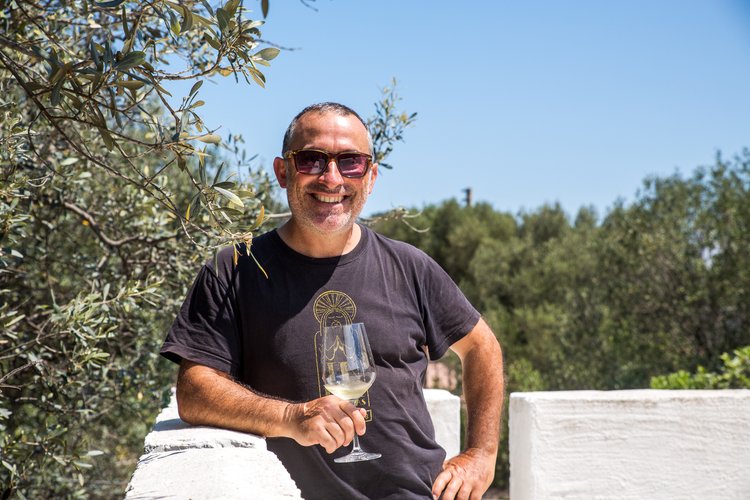

More Italy travel info
For more advice on planning your trip to Bologna and Italy more broadly, have a look at some of our other guides and itineraries!
